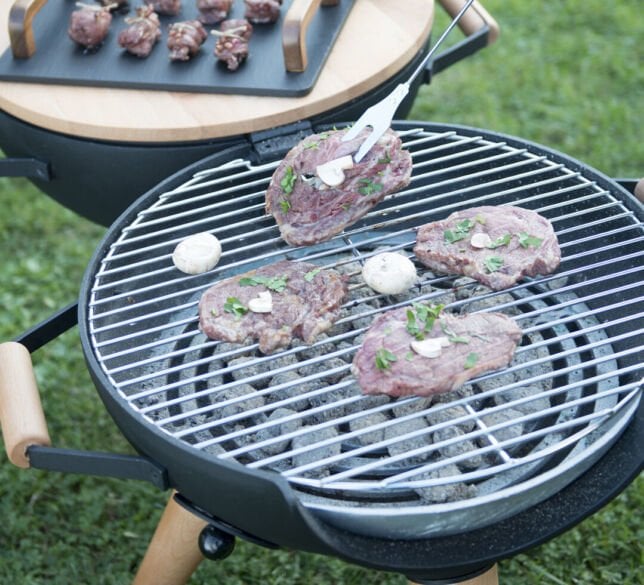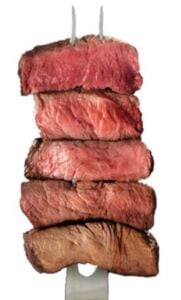Et Pişirme Teknikleri Temelleri

Bu yazımızda sizlerle et pişirme tekniklerine temel giriş yapıyoruz. Keyifli okumalar!
Izgarada Et Pişirme tekniğine mutfak dilinde ”konsantrasyon” pişirme tekniği denir. Amacı yiyecek maddenin öz suyunu ve tadını içinde bırakmaktır. Amaç yiyeceği önce yüksek ısıda bir müddet pişirerek, yüzeyinin pıhtılaşmasını sağlayıp, bünyedeki yayılabilir su ve tatların dışa çıkmasını engellemektir.
Mangal veya barbekü bir ızgara çeşididir. İnce veya kalın etlerin hepsine uygulanabilir. Et ateşin üstüne konarak (tahmini 300 derece ısı uygundur.) etin dış kısmı mühürlenir, her iki yüzü 1’er dakika mühürlenmelidir. Pişme derecesine göre her yüz 5 er dakika pişirilerek servis edilir.(Kalın etler için.)
Ateşin üstüne et pişirilirken, sık sık çevrilmemelidir,1 er kere çevirmek yeterlidir. Çok pişirmek etin suyunu kaybetmesine ve kurumasına neden olur.
Parça etlerden işlenerek yapılmış etler(Köfte) dışının yanmaması için kalın ete göre daha sık çevrilerek pişirilir.
İnce dilimlenmiş etleri ateşte toplamda 5 dk. pişirmek yeterli olur.(Pişme Derecesine göre ayarlanmalı.)
Izgarada dövülmüş et kullanmayın ve ızgaradan önce etleri sakın tuzlamayın, tuzlama etin kızarmasını engeller.
Etleri ızgara etmeden önce kurulayın, piştikten sonra su tadı almamalısınız.
Az Pişmiş(Rare) 52 Derece
Az Orta Pişmiş(Medium Rare) 55 Derece
Orta Pişmiş(Medium) 60 Derece
Orta İyi Pişmiş(Medium Well) 65 Derece
İyi Pişmiş (Well Done) 71 Derece
Et pişirilmeden önce dikkat edilmesi gereken bir husus var;
Kesimden hemen sonra et sert olur. Bu sertlik birkaç saat sürer. Hayvanın kesiminden sonra yer alan biyofiziksel ve biyokimyasal değişiklikler olgunlaştırma teriminin kapsamına girer. Bu sertlik sığırlarda 20 saat civarı, koyunlarda ise 12 saat devam eder ve daha sonra yavaş yavaş yumuşama başlar. Ancak bu süre uygun koşullarda geçerlidir. Bu süre yazın daha kısa, kışın daha uzun olabilir. Soğuk depoda +1 ile +3°C’de bir hafta saklandığında, daha iyi olgunlaşarak, etin lezzeti ve yumuşaklığı (sığırlar için) artar. Koyun ve kuzuların olgunlaşma süresi 3 gündür. Eğer, daha fazla bekletilirse, et daha çok yumuşar, ama tadı ve rengi değişebilir. Ancak İdeal depolama koşulları altında saklanırsa, sığır karkas veya budu 15 gün saklanabilir. Koyun-kuzu saklama süresi, ideal depolama koşullarında da olsa 3-4 günü geçmemelidir.
Artık yöntemlerine geçebiliriz;
DİREKT VE İNDİREKT PİŞİRİM
DİREKT PİŞİRİM
Direkt pişirim yiyecekleri mangalda ısı kaynağı üzerine direkt koyarak pişirmektir. Bu metodu ince ve çabuk pişebilecek küçük parçalar için uygundur. Mesela bonfile, burger eti, şiş, tavuk parçaları ve sebzeler gibi yiyecekler bu pişirime son derece uygundur. Bu yiyecekleri mangal üzerinde bir kez çevirmek pişmeleri için yeterli olacaktır.
Barbekünün kapağını kapatmadığınızda
Küçük-ince parça etleri kısa zamanda pişirmek için uygundur. Yiyeceklerin üzerindeki sosların yanmaması için ekstra özenle gözetlemek gerekir.
INDIREKT PİŞİRİM
Indirekt pişirim yiyecekleri ısı kaynağına daha uzakta tutarak ve barbekünün kapağı kapatılarak pişirme şeklidir. Bu yöntem fırında pişirme ile çok benzer olarak, ısının barbekünün içindeki tüm yüzeylere nüfus etmesini sağlar, böylece yiyecekler her taraftan eşit pişeceği için mangaldaki gibi çevirme işlemine gerek kalmaz. Bu kısık ateş ve yavaş pişirim metodu daha uzun sürede pişebilecek ve bu şekilde yanmayacak büyük parça yiyecekler için uygundur.
Barbekünün kapağını kapattığınızda
- Büyük parçaları eşit ısı dağılımı ile daha uzun sürede pişirmeyi sağlar.
- Yavaş pişirim için ısı kaynağını fazla alevlendirmemek gerekir. Bunun için de oksijen desteğini kontrollü olarak tutmak gerekir.
- Yiyecekleri islemek isterseniz de dumanın yiyeceğe iyice nüfus etmesi gerekir. Bunun için daha da uzun bir pişirim gerekir.
Alevlenmeyi minimize etmek için,
Endirekt pişirimlerde ısıya dayanıklı kabın içine su koyarak, kabı pişirim yapılan alana koymak gerekir. Ayrıca fazla yağ ya da sos kullanımından da kaçınmak gerekir.
Ateşin yandığı alanda küçük bir bölümü ateşsiz bırakmak birden yüksek ateşlenme olursa gıdaları aniden yanmamaları ve pişmeye devam edebilmeleri için avantaj oluşturur.
FÜME YAPMAK
Mangal pişirim için hız sağlarken, füme yapmak aroma katmak için birebirdir. Füme işlemi 180 ila 220 derece arası düşük ısı diye tabi ettiğimiz ısı derecelerinde ve genellikle mangal ile pişirim süresinin 3 katı kadar uzunlukta olur. Düşük dereceli pişirim eti yakmak yerine yavaş yavaş pişirerek, yanan tahtaların aromasını ete verir.
Bu işlemi ya füme işlemi için uygun olabilecek mangalda ya da geleneksel fümeleme yöntemleri ile yapmanız gerekir. Her iki uygulamada da endirekt pişirim esas alınır ve pişirim alanını nemlendirmesi için su dolu bir kap mangalın içine yerleştirilir. Ateşi alevlendirmek için ısı kaynağı arasına koyulacak su emici özellikle olan tahta parçaları ya da aroma vericiler kullanılabilir. Kapak kapatılarak sıcaklık ve dumanın yiyeceği sararak ve içine nüfus ederek, füme tadının yiyeceği geçmesi sağlanır. Yalnız şunu akılda tutmakta fayda var ki, tüm yiyecekler füme etmek için uygun değildir. Dana eti, kuzu eti, yağlı balık, tüm tavuk ve av hayvanları füme pişirimi için uygun seçeneklerdir.
FÜME YAPARKEN
Füme yapmak için uygun geleneksel tarzda pişiriciniz yoksa siz de elinizde olan kömürlü ya da gazlı mangalı füme işlemi için kapak kullanarak uygun hale getirebilirsiniz.
Kömürlü mangalda
- Tahta parçalarını ve diğer tutuşturmayı sağlayacak parçaları en az bir saat suda bekletin(eğer aromatik bir sıvı kullanacaksanız tahta parçalarını o sıvıda da yarım saat daha bekletmeniz gerekir) Önemli nokta; bu tahta parçalarını ateşe koymadan önce suyunu iyice süzdürmeniz gerekmektedir.
- Uzun maşa kullanın ve kömürlerin ya da kızgın küllerin arasına içi 2-3cm dolu olacak şekilde sıcak su içeren bir metal kap koyun.
- Islattığınız & aromatik özde beklettiğiniz tahta parçalarını köze ekleyin.
- Yiyecekleri mangalın üstüne yerleştirin ve kapağını kapatın.
- Yiyecekleri, su dolu kabı ve tahta parçalarını her saat başı kontrol edin.
- Füme işleminin son saatinde ısı kaynağına ekstra tahta parçaları eklemeyin. Fazla eklenen tahta parçaları yiyeceklerde acı bir tat yaratır.
Füme işlemi için daha detaylı paylaşımlarımız için takipte kalın.
ALÜMİNYUM PAKETLEME
Alüminyum folyoya sarma mangal için uygun olan elle yapılacak bir işlemdir. Bu hem yiyecekleri saklamak ve sıcak tutmak için uygunken, aynı zamanda mangalda pişirim yapmak için de çok uygun bir yöntemdir. Alüminyum ile paketlenmiş gıdalar mangal kanallarının üzerine konulur ve tahıllı ekmeği ılıtmak, sebze buğulamak ve etleri pişirmek için mükemmel bir yöntemdir. Tabi bu yöntem yiyecekleri direkt olarak mangal kanallarına koyduğunuzdaki tadı vermese de yiyeceklerin nemli kalmasını sağlar, yumuşaklığı arttırır ve mangal sonrası temizliği kolaylaştırır. Eğer birden çok yiyeceği aynı pakette sarıp, pişirecekseniz; bunların aynı zaman aralığında pişen yiyecekler olmasına dikkat etmeniz gerekir.
